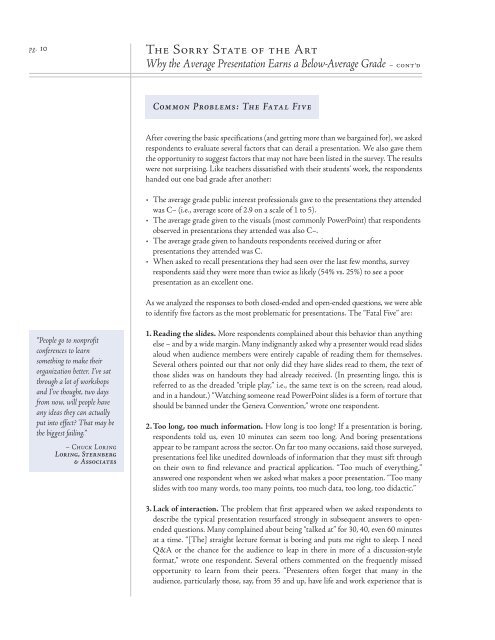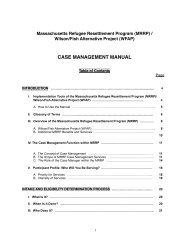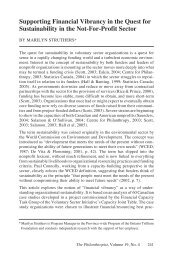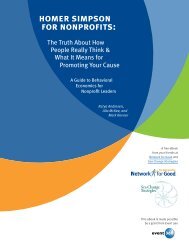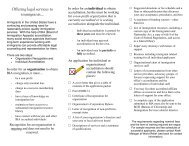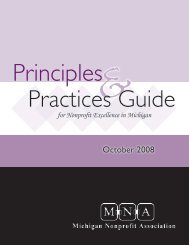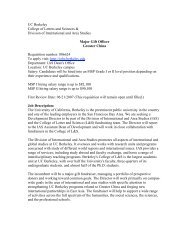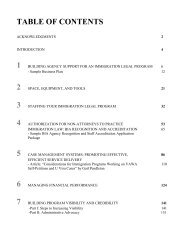Why Bad Presentations Happen to Good Causes - The Goodman ...
Why Bad Presentations Happen to Good Causes - The Goodman ...
Why Bad Presentations Happen to Good Causes - The Goodman ...
You also want an ePaper? Increase the reach of your titles
YUMPU automatically turns print PDFs into web optimized ePapers that Google loves.
pg. 10<br />
“People go <strong>to</strong> nonprofit<br />
conferences <strong>to</strong> learn<br />
something <strong>to</strong> make their<br />
organization better. I’ve sat<br />
through a lot of workshops<br />
and I’ve thought, two days<br />
from now, will people have<br />
any ideas they can actually<br />
put in<strong>to</strong> effect? That may be<br />
the biggest failing.”<br />
– Chuck Loring<br />
Loring, Sternberg<br />
& Associates<br />
<strong>The</strong> Sorry State of the Art<br />
<strong>Why</strong> the Average Presentation Earns a Below-Average Grade – cont’d<br />
Common Problems: <strong>The</strong> Fatal Five<br />
After covering the basic specifications (and getting more than we bargained for), we asked<br />
respondents <strong>to</strong> evaluate several fac<strong>to</strong>rs that can derail a presentation. We also gave them<br />
the opportunity <strong>to</strong> suggest fac<strong>to</strong>rs that may not have been listed in the survey. <strong>The</strong> results<br />
were not surprising. Like teachers dissatisfied with their students’ work, the respondents<br />
handed out one bad grade after another:<br />
• <strong>The</strong> average grade public interest professionals gave <strong>to</strong> the presentations they attended<br />
was C– (i.e., average score of 2.9 on a scale of 1 <strong>to</strong> 5).<br />
• <strong>The</strong> average grade given <strong>to</strong> the visuals (most commonly PowerPoint) that respondents<br />
observed in presentations they attended was also C–.<br />
• <strong>The</strong> average grade given <strong>to</strong> handouts respondents received during or after<br />
presentations they attended was C.<br />
• When asked <strong>to</strong> recall presentations they had seen over the last few months, survey<br />
respondents said they were more than twice as likely (54% vs. 25%) <strong>to</strong> see a poor<br />
presentation as an excellent one.<br />
As we analyzed the responses <strong>to</strong> both closed-ended and open-ended questions, we were able<br />
<strong>to</strong> identify five fac<strong>to</strong>rs as the most problematic for presentations. <strong>The</strong> “Fatal Five” are:<br />
1. Reading the slides. More respondents complained about this behavior than anything<br />
else – and by a wide margin. Many indignantly asked why a presenter would read slides<br />
aloud when audience members were entirely capable of reading them for themselves.<br />
Several others pointed out that not only did they have slides read <strong>to</strong> them, the text of<br />
those slides was on handouts they had already received. (In presenting lingo, this is<br />
referred <strong>to</strong> as the dreaded “triple play,” i.e., the same text is on the screen, read aloud,<br />
and in a handout.) “Watching someone read PowerPoint slides is a form of <strong>to</strong>rture that<br />
should be banned under the Geneva Convention,” wrote one respondent.<br />
2. Too long, <strong>to</strong>o much information. How long is <strong>to</strong>o long? If a presentation is boring,<br />
respondents <strong>to</strong>ld us, even 10 minutes can seem <strong>to</strong>o long. And boring presentations<br />
appear <strong>to</strong> be rampant across the sec<strong>to</strong>r. On far <strong>to</strong>o many occasions, said those surveyed,<br />
presentations feel like unedited downloads of information that they must sift through<br />
on their own <strong>to</strong> find relevance and practical application. “Too much of everything,”<br />
answered one respondent when we asked what makes a poor presentation. “Too many<br />
slides with <strong>to</strong>o many words, <strong>to</strong>o many points, <strong>to</strong>o much data, <strong>to</strong>o long, <strong>to</strong>o didactic.”<br />
3. Lack of interaction. <strong>The</strong> problem that first appeared when we asked respondents <strong>to</strong><br />
describe the typical presentation resurfaced strongly in subsequent answers <strong>to</strong> openended<br />
questions. Many complained about being “talked at” for 30, 40, even 60 minutes<br />
at a time. “[<strong>The</strong>] straight lecture format is boring and puts me right <strong>to</strong> sleep. I need<br />
Q&A or the chance for the audience <strong>to</strong> leap in there in more of a discussion-style<br />
format,” wrote one respondent. Several others commented on the frequently missed<br />
opportunity <strong>to</strong> learn from their peers. “Presenters often forget that many in the<br />
audience, particularly those, say, from 35 and up, have life and work experience that is


